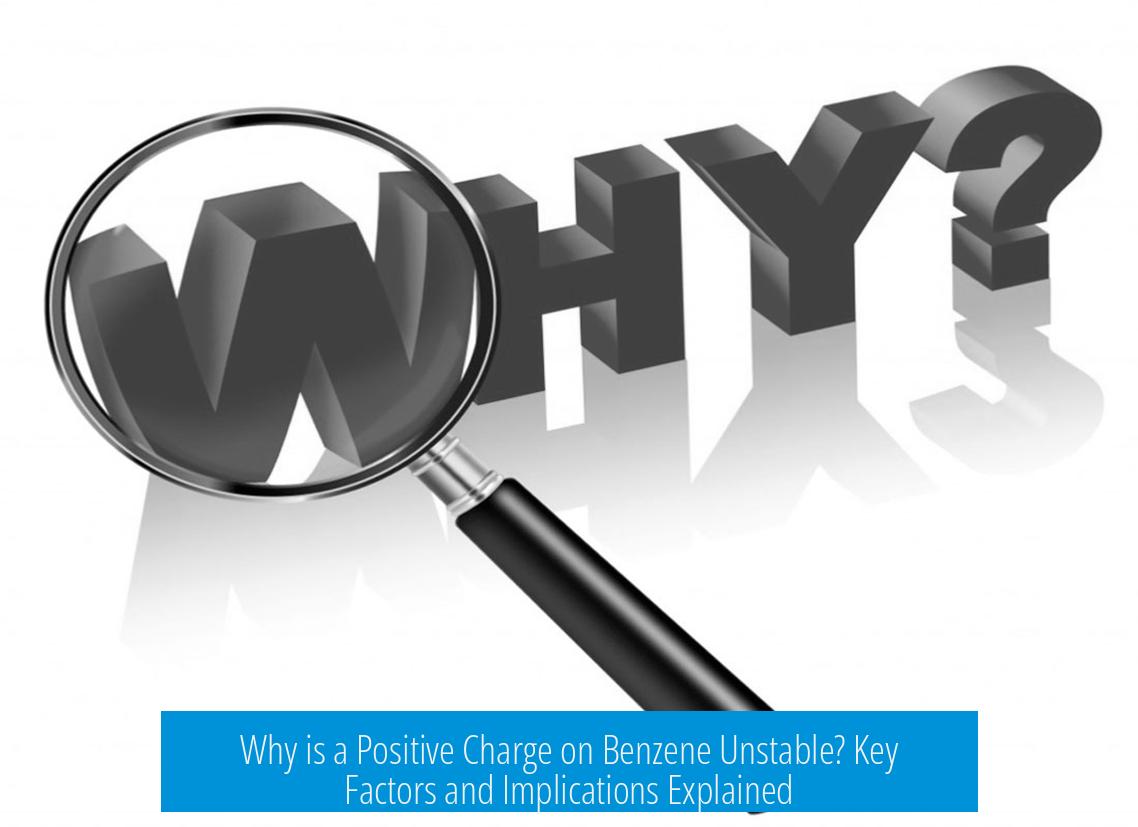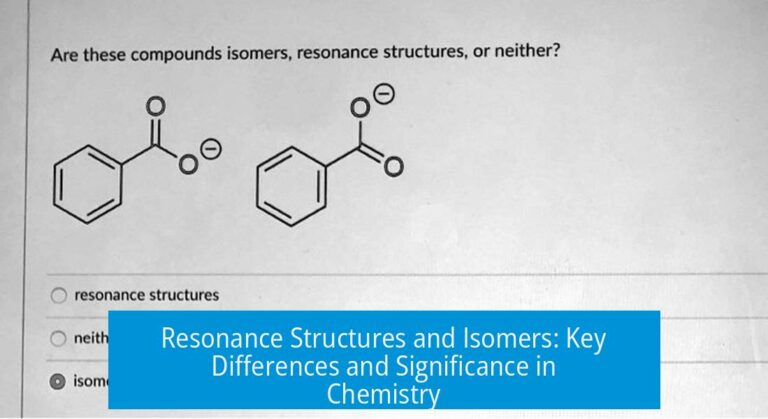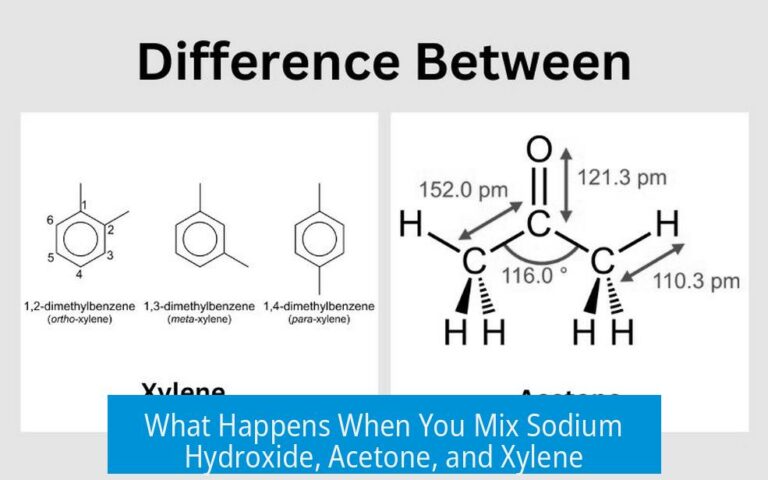Why is a Positive Charge on Benzene Unstable?

A positive charge on benzene is unstable because it disrupts the aromaticity and resonance stabilization of the benzene ring, localizing the charge on a single carbon that cannot effectively delocalize it. This loss of delocalization and aromatic character greatly reduces the molecule’s inherent stability. Several factors contribute to this instability, including loss of resonance, charge localization, electron density concentration, and the sp2 hybridization of the carbon bearing the charge.
Aromaticity and Stability

Benzene’s core stability comes from its aromaticity. It is a cyclic compound with six carbon atoms in a planar ring, featuring alternating single and double bonds.
- The six π-electrons in benzene are fully delocalized, creating a resonance-stabilized electronic structure.
- This delocalization gives benzene its special stability called aromaticity.
- Aromaticity is associated with lower energy and enhanced stability compared to non-aromatic structures.
When a positive charge is introduced directly on the benzene ring, this aromatic system is disrupted. The charge impairs the resonance that normally stabilizes the π-electron cloud. This leads to a loss of aromaticity and a corresponding rise in the system’s energy, making the positive charge unstable.

Disruption of Resonance by Positive Charge
The positive charge forces electrons out of the delocalized π-system because it localizes the charge on a specific carbon atom.

- Normally, these π-electrons spread across all six carbon atoms.
- Introduction of a carbocation on a benzene carbon means that the resonance structures that spread the positive charge over multiple atoms no longer hold effectively.
- This partial or complete loss of resonance stabilization elevates the overall energy of the molecule.
Hence, the delocalization of electrons ceases, and the stable aromatic system becomes destabilized. The lack of charge distribution results in a high local positive charge density, which is unfavorable.
Orbital Configuration and Conjugation Loss

The sp2 carbon bearing the positive charge alters the orbital landscape of the ring. This carbon may possess two p orbitals, one for bonding and one representing the vacant orbital associated with the positive charge.
- The newly introduced p orbital containing the positive charge does not conjugate with the other ring orbitals.
- This breaks the continuous overlap of p orbitals that is essential for maintaining full resonance.
- Although aromaticity might still be partially preserved in some special orbital structures, the effective conjugation required to stabilize the charge is compromised.
This loss reduces benzene’s ability to maintain the aromatic π-electron cloud, contributing further to the instability of the positive charge.

Charge Localization and Its Effects
The positive charge in this system remains localized on the carbon bearing the charge and cannot effectively move around the ring.
- Localization increases the positive charge density at one site, making it less stable.
- Delocalization normally spreads out the charge, reducing repulsion and increasing stability.
- In benzene with a positive charge, this spreading is inhibited, resulting in greater destabilization.
Furthermore, the presence or absence of electron-donating or -withdrawing substituents near the charged carbon influences stability:
- Electron-donating groups (EDGs) can stabilize the positive charge by providing electron density.
- Electron-withdrawing groups increase positive charge density, worsening instability.
Electron Density and Charge Concentration
A high concentration of positive charge creates an unstable electronic environment. Benzene’s aromatic π-cloud normally stabilizes charges by delocalization. When this is compromised:
- The accumulated positive charge on one atom faces strong electrostatic repulsion.
- The inability to spread out the charge makes the positive charge highly reactive and energetically unfavorable.
- Electron-withdrawing substituents nearby exacerbate this by pulling electron density away, increasing charge density.
Instability of sp2 Carbocations Compared to sp3
Benzene carbons are sp2 hybridized. Positive charges on these carbons exhibit lower stability than those on sp3 carbons.
- sp2 carbons have higher electronegativity due to increased s-character.
- This electronegativity makes them less willing to bear a positive charge.
- Consequently, positive charge localization on an sp2 carbon is energetically unfavorable.
This contributes to the inherent instability of positive charges on benzene carbons.
Special Cases and Exceptions
While a positive charge directly on benzene carbons is generally unstable, some exceptions exist:
- Benzylic carbocations, where the positive charge lies on a carbon adjacent to the benzene ring, are stabilized by resonance with the aromatic system.
- Positive charges may form transiently during specific reaction mechanisms, such as diazonium salt decomposition or mass spectrometry processes.
- These cases do not involve loss of aromaticity in the benzene ring itself.
Hence, the instability challenge is specific to carbons within the aromatic ring bearing the positive charge.
Summary of Key Points
- Benzene’s aromaticity provides significant stability via delocalized π-electrons.
- A positive charge directly on benzene disrupts aromatic π-electron resonance.
- Localization of the positive charge prevents delocalization, increasing instability.
- The sp2 hybridized carbon bearing the positive charge is less capable of stabilizing it.
- Loss of resonance and charge localization raise the molecule’s energy.
- Electron-donating groups can stabilize the charge; electron-withdrawing groups worsen instability.
- Benzylic carbocations are more stable due to resonance with the benzene ring.
Why is a Positive Charge on Benzene Unstable?
Simply put, a positive charge on benzene is unstable because it disrupts the aromaticity and resonance that normally stabilize the benzene ring. When a carbon atom in benzene carries a positive charge, the usual electron dance that makes benzene so stable comes to a screeching halt. Let’s break this down to understand why this happens and what makes benzene so picky about its charges.
Benzene isn’t your everyday molecule. Picture it as a perfectly balanced dance floor of six carbons, each contributing a delicate step of electrons, continuously swapping partners through resonance. This dance results in a cloud of electrons spread evenly over the carbons, making benzene extremely stable and resistant to disruption. Introducing a positive charge drops the bass and throws the party into chaos.
Localization of the Positive Charge: Put a Pin on It!
The core of the problem lies with how the positive charge behaves. In many molecules, charges spread out via resonance, lowering the overall energy and increasing stability. Unfortunately, when a positive charge appears on a single carbon within benzene, it’s like an unruly guest hogging the dance floor—it stays put, localized, and refuses to share.
This lack of delocalization means the positive charge sits heavily on one carbon, creating an area of high charge density that nature doesn’t like. So, while the party was once harmonious, now one corner is overwhelmed, making the entire ring less stable.
Loss of Resonance Stabilization: When the Music Stops
Resonance is benzene’s secret weapon. Through resonance, electrons shift positions around the ring, giving the stability of a bunch of overlapping musical notes forming a perfect chord. But put a positive charge on a carbon, and this chord falls apart.
A resonance structure provides extra stability to benzene. With that positive charge, some resonance structures become impossible—imagine a missing instrument in your band. The result? Benzene loses some of that prized stability and the energy of the molecule shoots up.
Disruption of Orbital Conjugation: Too Many P’s Spoil the Pleasure
Every carbon in benzene normally has one p orbital that overlaps to create a continuous conjugated system—essentially a smooth electron highway. When a carbon gets a positive charge, it acquires an additional p orbital, but this new orbital doesn’t play nicely with the rest of the ring. The p orbital conjugation is disrupted.
However, it’s important to note that the overall aromaticity of the benzene ring often remains intact despite this orbital hiccup. The positive charge’s presence just pokes a hole in the smooth electron flow, causing instability but not total collapse.
Unstable sp2 Carbocation: The Hot Potato Carbon
Benzene carbons are sp2 hybridized—meaning they have significant s-character in their orbitals, holding electrons tightly. When such a carbon carries a positive charge, it’s more unstable than its sp3 counterparts in other carbons because the positive charge is held in a smaller, tighter orbital region, increasing its energy.
So while carbocations in other parts of a molecule might cool off quickly, sp2 carbocations in benzene tend to rage with instability.
Special Case: Benzylic Carbons Rock a Positive Charge
Not all carbocations near benzene are troublemakers. The positive charge right on the benzene ring is a disaster, but if the positive charge is on a benzylic carbon (that is, one carbon just outside the ring but attached to it), the story changes dramatically.
Benzylic carbocations are much more stable because the positive charge can delocalize into the aromatic ring’s resonance system. These types appear frequently in organic mechanisms like diazonium decomposition and even show up in mass spectrometry.
Loss of Aromaticity: The Heartbreaker
Perhaps the biggest deal-breaker is the loss of aromaticity. Benzene’s exceptional stability is tied directly to its aromatic nature—a cyclic, planar molecule with a conjugated pi-electron system satisfying Hückel’s rule.
Forming a positive charge on the ring carbons often involves sacrificing this aromatic character. Lose aromaticity, and you lose huge energetic bonuses, making the positively charged species much less stable.
What About Electron Density and Neighboring Effects?
High electron density areas like those with positive charges prefer to spread the love—diffuse charge to lower instability. Since the benzene positive charge refuses to delocalize, it causes a spike in charge density that’s energetically unfavorable.
Also, neighboring groups can either stabilize or destabilize the charge. Electron-donating groups nearby can help by sending electrons towards the positive site, softening the impact. But nearby electronegative atoms or groups that pull electrons away exacerbate instability by increasing the positive charge’s intensity.
Final Thoughts: Why Does This Matter?
Understanding why a positive charge on benzene is unstable isn’t just academic—it’s crucial in synthetic chemistry and reaction mechanisms. When chemists see a carbocation forming, they know that if it’s right on the benzene ring, the molecule is under serious strain. This knowledge helps predict reaction pathways, design catalysts, and even develop pharmaceuticals where aromatic systems are key players.
In summary, the instability comes from a nasty combination of factors:
- Charge localization without resonance delocalization
- Loss of aromaticity and resonance stability
- Disrupted conjugation of p orbitals
- Unfavorable sp2 carbocation characteristics
- High charge density with insufficient electron donation
So next time you picture benzene as that calm, composed hexagonal molecule, remember—put a positive charge on one of its carbons, and you’ve got a real party pooper on your hands.
Why does a positive charge on benzene disrupt its aromaticity?
A positive charge localizes on one carbon, breaking the continuous overlap of p orbitals that maintains aromaticity. This loss reduces the resonance stabilization that normally holds the ring stable.
How does the positive charge affect resonance in benzene?
The positive charge stops full delocalization of π electrons. Some resonance structures become unavailable, causing partial loss of resonance and making the molecule unstable.
Why is the positive charge on an sp² carbon less stable?
sp² carbons, like those in benzene, have more s-character and hold electrons closer to the nucleus. Being positively charged here leads to higher energy and less stability compared to sp³ carbons.
Can adjacent atoms stabilize a positive charge on benzene?
Adjacent electron-donating groups help spread out the charge and stabilize it. Without these groups, the charge remains localized, increasing instability.
Are there cases where a positive charge on benzene is stable?
Yes, in transient states like mass spectrometry or specific reactions, positive charge appears. Benzylic carbocations, next to the ring, are much more stable due to resonance.





Leave a Comment